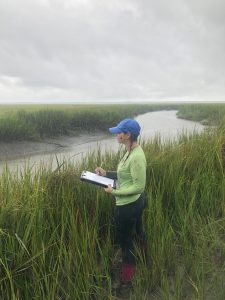To know me is to understand that music is my outlet and biology is my passion. I often find myself going back to the lyrics of Miley Cyrus’ “The Climb” to reminisce on the very journey that has brought me here, to Georgia Southern University, working as a graduate student and a Georgia Sea Grant research trainee.
If there was one word to describe my life, it would be the word “climb.” Growing up, I struggled to find a path that felt right and was my own. Though, my admiration for the natural world provided comfort and a sense of belonging that led me to chase a career in biological sciences.

Hurt gathering data and working on the living shoreline at Cannons Point. Photo by by Billy Annis
My climb, an uphill battle, has not always been easy. I went to community college the first few years of my undergraduate degree, going to school part-time and working nearly full time. Once I could afford to go back to school full time, I transferred to a four-year university and started working in the aquatic ecology and hydrology labs on campus. I gained experience studying microplastics and working for the surface water and tile hydrology research team. I also landed my job as a fisheries technician for the Illinois DNR, and even published my first scientific manuscript as primary author.
Embracing the climb, after graduation I accepted a graduate position at GSU where I’m currently working as a Georgia Sea Grant research trainee studying various aspects of environmental DNA (eDNA) technologies. Traditional species monitoring can be expensive, time consuming, and physically taxing. By working to further develop eDNA technologies, we could potentially eliminate many of these difficulties, making eDNA a great tool for researchers and wildlife managers alike. Therefore, my research is focused on 3 central questions, can eDNA be quantified to represent actual species abundances? How long can eDNA persist in an environment before degrading beyond detectability? And can eDNA be used a viable tool in pair or in place of traditional monitoring techniques?
The traineeship has made my new climb to finishing my master’s degree very special. While the pandemic has altered some experiences, the virtual onboarding and meetings that Marine Extension and Georgia Sea Grant has hosted have been very advantageous in helping me to further navigate my future in this field.
My climb to get where I am today was rocky and rugged, but those experiences were solely responsible for molding me into the successful scientist I am today. I used to be fearful of my future unexplored climbs, but I now welcome them with open arms.
To end on a similar note, I leave you with these lyrics.
“Cause I, I’m in love
With my future
Can’t wait to meet her” – Billie Eilish

